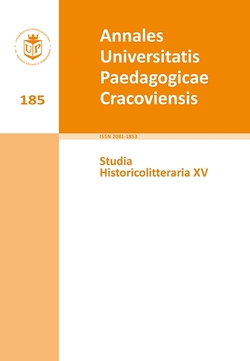Некоторые особенности универсального пространства войны в романе Олега Ермакова „Знак зверя”
Hauptsächlicher Artikelinhalt
Abstract
Universal space of war in Oleg Yermakov's Sign of the beast
In his clearly pacifistic and anti-war book, a contemporary Russian writer Oleg Yermakov projects such an image of war which at a mythological level could be compared to the vision of hell. The main topic of the book is signalled through its title and motto, taken from the Book of Revelation (14:11): “And the smoke of their torment will rise for ever and ever. There will be no rest day or night for those who worship the beast and its image”.
The beast found in the novel is a personification of war, which in the writer’s view is unhuman and pointless. By combining in his writing visual and acoustic effects, as well as by making use of biblical symbols, Yermakov creates a universal space of evil. The space mentioned is composed of ideas of emptiness, ideological void, world without God, death, recurrence of phenomena which bears the signs of eternity, endlessness. The universal nature of the problem discussed was signalled through setting the plot in unspecified space and time. Anonymity and typicality are the dominant features. The writer is concerned with human reaction to evil, degradation of personality of one consciously taking part in war, the notion of complicity, and responsibility for one’s actions.
Key words: Oleg Jermakow; Sign of the beast; space; war; evil; biblical symbols;
Downloads
Artikel-Details

Dieses Werk steht unter der Lizenz Creative Commons Namensnennung - Nicht-kommerziell - Keine Bearbeitungen 4.0 International.
URHEBERRECHTE
Der Herausgeber der „AnnalesUniversitatisPaedagogicaeCracoviensis. StudiaHistoricolitteraria” ist zur Nutzung und Verbreitung aller in der Zeitschriftveröffentlichten Materialien auf Grundlage eines nicht ausschließlichen, zeitlich unbeschränkten Lizenzvertrags befugt, der im Voraus unbefristet mit jedem/r Autor/in des jeweiligen Werks für die im betreffenden Vertrag vereinbarten Nutzungsbereiche abgeschlossen wird.
POLITIK DES OFFENEN ZUGRIFFS
Die „AnnalesUniversitatisPaedagogicaeCracoviensis. StudiaHistoricolitteraria” sind eine Fachzeitschrift mit freiem Zugriff, dessen voller Inhalt kostenlos für Nutzer und Einrichtungen auf Grundlage einer nicht ausschließlichenCreativeCommons-Lizenz (CC BY-NC-ND 4.0) verfügbar ist. Die Nutzer/innen können die Artikel in dieser Zeitschriftohne vorherige Zustimmung des Herausgebers oder des/r Autors/in lesen, herunterladen, Kopien anfertigen, verbreiten, drucken oder zu Volltexten verlinken, insofern die Quelle des Zugriffs und der/die Autor/inder jeweiligen Publikation angegeben wird. Dies ist mit der BOAI-Definition des offenen Zugriffs konform (http://www.soros.org/openaccess).
Literaturhinweise
Глизнуца В., Символика цвета в романе Ф.М. Достоевского Преступление и наказание, http://www.nsportal.ru.
Гутрина Л., Парамонова Л., „Огневой горизонт” Петербурга: цветовая символика А. Белого, „Филологический класс” 2013, № 2(32).
Дербина Г., Тайна желтого букета Маргариты, http://www.litsovet.ru.
Ключинская О., Военная проза О.Н. Ермакова: проблематика жанрово-стилевого единства. Автореферат диссертации на соискание ученой степени кандидата филологических наук, Владивосток 2010.
Ключинская О., Проблемно-тематические аспекты современной военной прозы, „Гуманитарные исследования в Восточной Сибири и на Дальнем Востоке” 2010, № 4.
Магические символы: Солнце, [в:] Объекты и явления природы, http://www.magicysm.ru.
Nocuń M., Brzezicki A., Sieroty po imperium, „Tygodnik Powszechny” 15.12.2009, http://www.tygodnik.onet.pl.
Пустовая В., Человек с ружьем: смертник, бунтарь, писатель: о молодой военной прозе, „Новый мир” 2005, № 5.
Sałajczykowa J., „Afgańska” proza Olega Jermakowa, „Przegląd Humanistyczny” 1998, № 1(346).
Символы, знаки, эмблемы, http://www.slovari.yandex.ru.
Табатадзе Х., Мифологема провинционального города в романе Ф. Сологуба Мелкий бес, http://www.dspace.nbuv.gov.ua.
